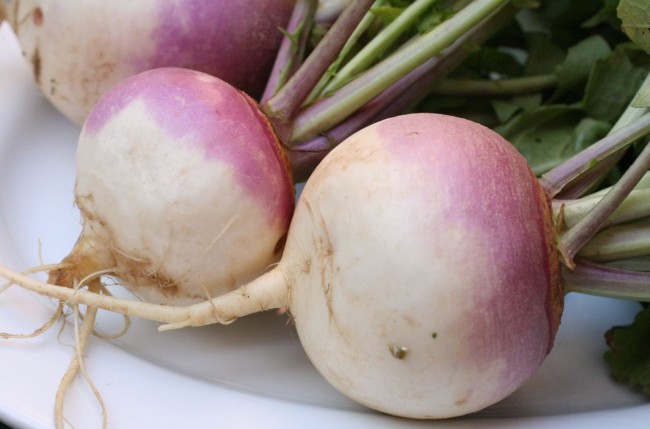
Turnips are root vegetables closely related to rutabagas, radishes and carrots. Archaeological evidence shows that turnips were cultivated before the fifteenth century BCE in India where their seeds were used for oil. One type of modern canola oil is derived from the seeds of the plant species to which turnips belong—brassica rapa. Turnips have been used since before recorded history and were well known to the Greeks and Romans. The Roman scholar Pliny the Elder extolled the benefits of the turnip, claiming it to be one of the most valuable vegetables on Earth because of how easy they are cultivated and how useful and healthy they are as food for both humans and livestock. The turnip grows mostly underground with the exception of the greens that emerge from it and the round top part of the root. The top part of the turnip consists of stem material but it fuses with the root. This exposed portion of the turnip turns colors when exposed to sunlight and it can be red, purple or green. Because turnips are closely related to radishes, they have similar flavors and textures, although the turnip is much milder, similar to the flavor of raw cabbage. The turnip plant is usually grown for its root, but the greens are useful as well. Turnip greens are similar in flavor to mustard greens and they are used as a salad green, either raw or lightly cooked.
The turnip root is commonly used as a side dish and is generally cooked. Roasting, sautéing and boiling turnips are great ways to prepare the vegetable. Turnips pair well with flavors like lemon, ginger, cabbage and honey. Because of their lightness, turnips also work well with heavy, fatty dishes that incorporate meats like bacon beef and pork. Mashed turnips are a flavorful and lighter alternative to mashed potatoes. Serve mashed turnips with chives, parmesan and butter. Leek, potato and turnip along with onion, and chicken or vegetable stock make for a hearty soup. Turnips can be used raw in salads to add crunch and flavor. For a wonderful side dish, roast sliced turnips with grated ginger, canola or olive oil, and honey. Roast at 400 degrees and check the turnips frequently because cooking time may vary widely based on the thickness and density of the turnips. Roast until turnips are tender but not mushy. Cut turnips into thick sticks and pan fry with paprika, garlic salt and onion power and top with parmesan cheese for a low-carb alternative to French fries.
Pick turnips that are plump and heavy for their size, and free from any large blemishes. The weight of the turnip indicates whether it is dry or not. Turnips last much longer when stored in a dark place with high humidity. Since turnips have high water content, they do not store very well in dry climates or in the refrigerator. Before storing turnips, remove the greens from their tops because the leaves will cause the turnips to lose moisture more quickly. If desired, store the greens in the refrigerator in a sealed plastic container. Store the root itself in a separate container in the refrigerator, preferably in the crisper. Turnips will stay fresh for about a week, the greens won’t keep that long, about three or four days. Be sure to wash all produce before use.


 BACK TO PRODUCTS
BACK TO PRODUCTS